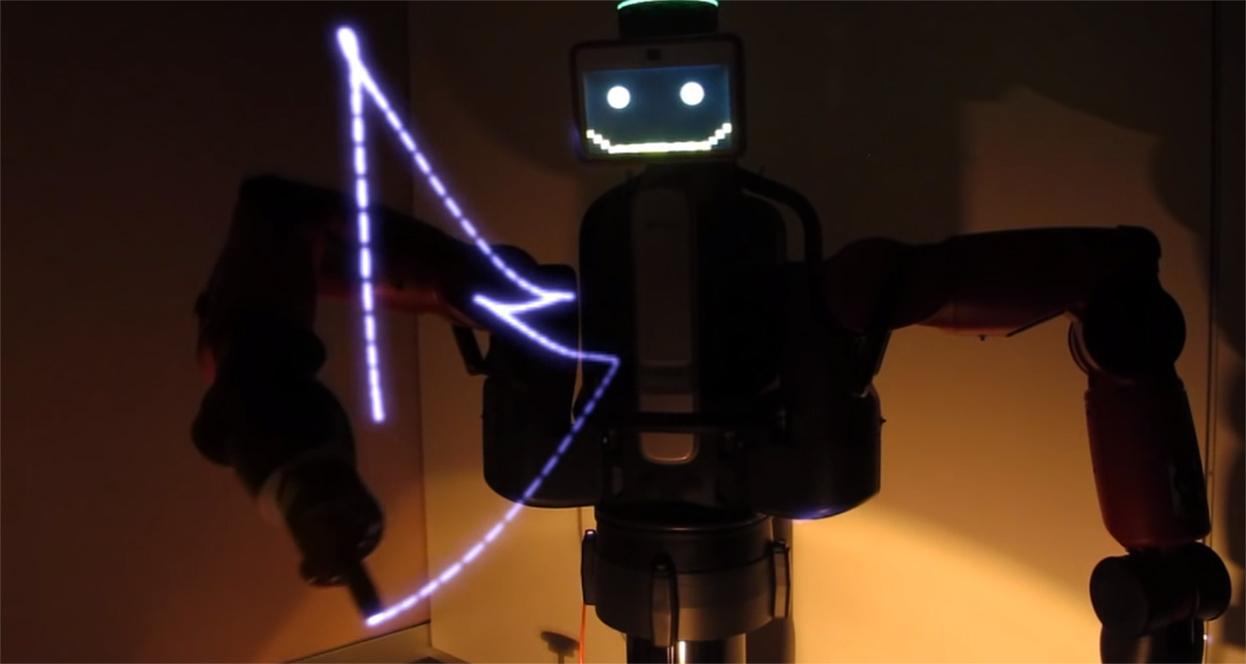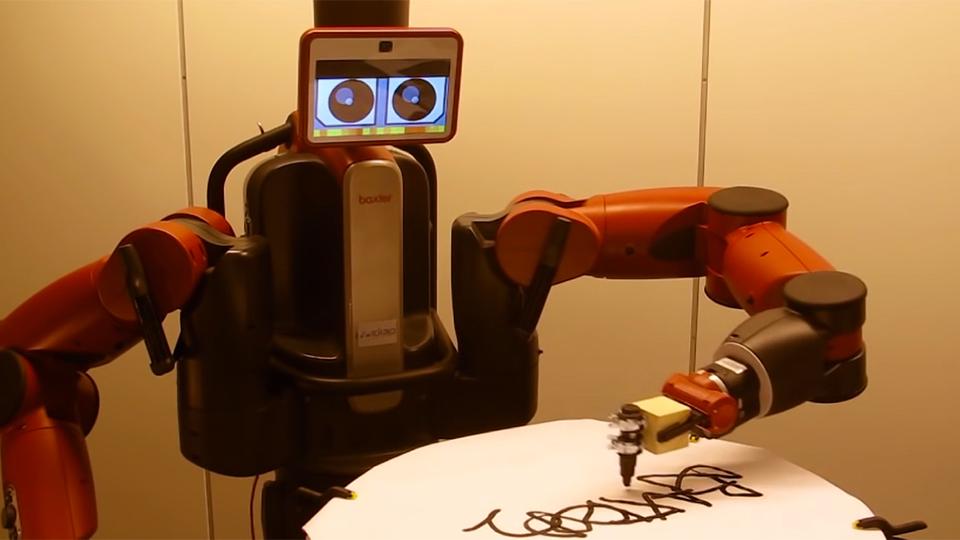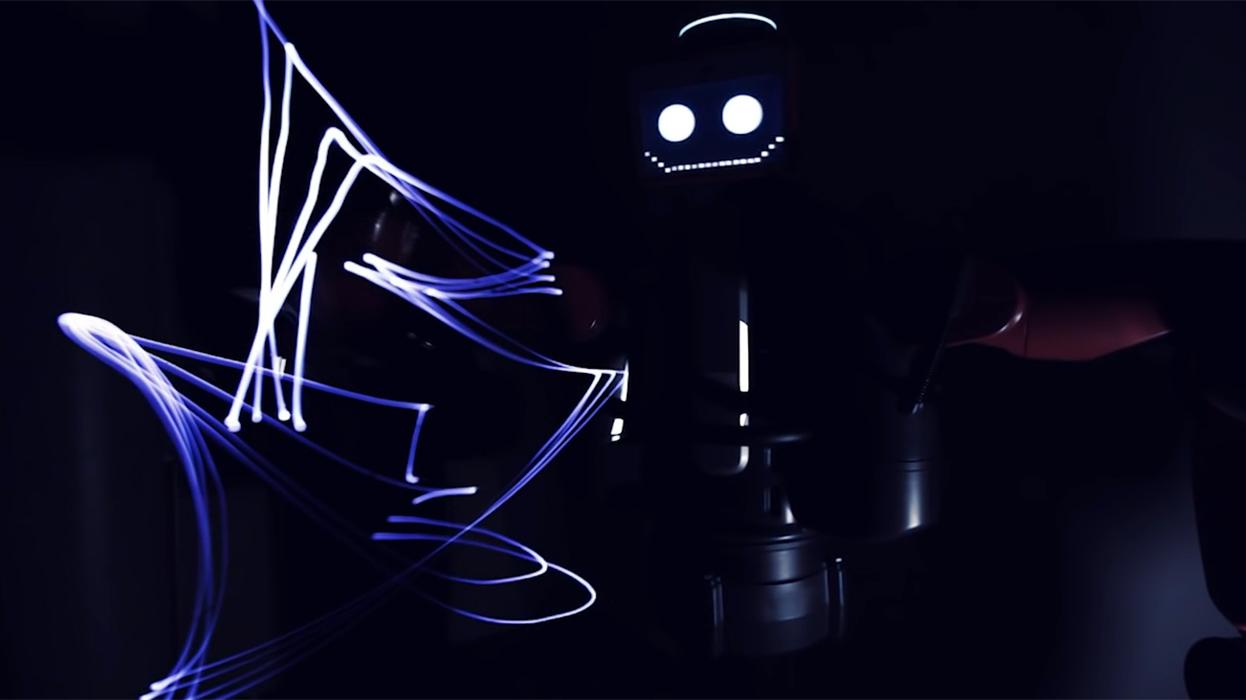Robot graffiti artist Baxter learns to tag like a human
Primary page content
Goldsmiths, University of London is proud to present its latest unique and highly-skilled international art star: a robot called Baxter.

Baxter paints with light!
Researchers from the Department of Computing, in collaboration with Idiap Research Institute in Martigny, Switzerland, are developing a machine with the fluidity to reproduce graffiti tags in pen, paint and neon lights.
The Baxter robot has been taught to write its own name in a stylised graphic form known as a tag - which first emerged in late-1960s New York - and is being taught to reproduce other graffiti tags using the same types of movements that a human would use for the skilled task.
Drawing machines created to write, copy or generate art have existed for at least three centuries. Designed by Jacquet Droz (1721-90), one of the first drawing mechanical automatons could write sentences in cursive script.
From the 1970s, British artist Harold Cohen (1928–2016) developed a computerised system, named AARON, to compose artworks derived from Cohen’s stylistic ideas, and further work has been done to create machines to replicate East Asian calligraphy strokes or acrylic paint on canvas.
But drawing and handwriting in a convincingly human manner are challenging tasks for robots. Even for humans, a long time is required from childhood to learn how to manipulate a pen to produce smooth and elegant sequences of letters, such as a signature.

Graffiti tags are a calligraphic form of writing: the letters composing the tag are not important in their semantic meaning but are instead designed to impress the viewer with a figurative form and style.
While most approaches to mimicking this human trait rely on precise and stiff position-controlled robots, and only superficially emulate the essence of human drawing skills, the Baxter has far more advanced drawing skills.
The robot artist has been built by Goldsmiths and Idiap Research Institute using a commercially available “smart, collaborative” machine Baxter.
Manufacturing companies often use the Baxter as a workforce factory robot, but this modified Baxter has been designed to draw computer generated calligraphy and graffiti art with a marker on paper, or trace contours and shapes in the air in a robotised “light painting” performance.
The team formed of Professor Frederic Fol Leymarie and PhD candidate Daniel Berio from Goldsmiths and Dr Sylvain Calinon from Idiap Research Institute aim to develop computational models that enable the transfer of complex personal artistic skills to robot platforms.

In creating this artistically skilled humanoid robot, they are using their research into different aspects of human motor skills, and the perceptual processes and movement dynamics underlying the production of various forms of art.
While most robotic manipulators focus on careful reproduction of the brush pressure and footprint of a human pen or paintbrush, this new development emphasises the relationship between the movement employed in a trajectory and the resulting trace.
Weights constrain Baxter’s movements to approximate a human arm while writing (weighted inverse kinematics), with a weighting scheme chosen based on the mechanical properties of the manipulator. This improves tracking accuracy and stability while Baxter is drawing. Baxter’s system then adjusts each planned stroke of the pen in order to compensate for tracking errors.
This month the Goldsmiths and Idiap team presented their research at the 2016 International Conference on Intelligent Robots and Systems (IROS) in South Korea. Professor Fol Leymarie also chaired the conference’s workshop on Artistically Skilled Robots, together with Daniel Berio and Sylvain Calinon.
Development on the artistically skilled Baxter continues.
Download the paper ‘Learning dynamic graffiti strokes with a compliant robot'
Find out more on the project website or read about Baxter on TechRadar